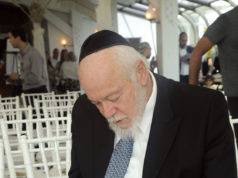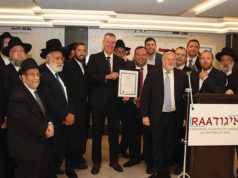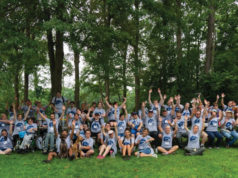
The alluring beauty, pristine beaches, ideal climate and music festivals make Barbados one of the world’s top tourist spots. What’s more, this easternmost Caribbean island offers Jewish visitors Kabbalat Shabbat services in an exquisitely reconstructed historic synagogue; a new interactive Jewish museum; and a recently excavated mikveh, the oldest known in the Western Hemisphere.
These achievements of the island’s 16 Jewish families are all the more remarkable when you discover that the legacy of Barbados Jewry almost disappeared without a trace.
The low point came on April 27, 1928. Edmund Isaac Baeza, the last surviving member of the original Jewish community—established in 1654 by Sephardic Jews fleeing the Inquisition—sold the synagogue, Nidhe Israel (The Scattered of Israel), to a Bridgetown solicitor for use as a law library. Baeza sent the proceeds of the sale—600 British pounds—along with the synagogue’s religious objects to the Bevis Marks Spanish-Portuguese Congregation in London. Six years later, the property was sold again. This time the new owner converted the former synagogue into an office building and let its adjacent cemetery fall into ruin.
The prospect of such a historical injustice was unthinkable to another Bridgetown attorney, Eustace Maxwell Shilstone, 41, a non-Jew who held a lifelong fascination for the synagogue. “I remember,” he wrote, “as a child of about eight, being taken by one of the daughters of the late Mr. E. S. Daniels, the last rabbi of the synagogue, to see the building, and having the meaning of its various appointments explained to me.”
Shilstone established his law office across from Nidhe Israel on Synagogue Lane. “Every Saturday morning,” he wrote, “an old woman who lived in the shabby ruins of the rabbi’s house within the confines of the yard opened the entrance gate.” Shilstone would frequently drop in “to enjoy the peaceful scene and to read in a casual way one or two of the inscriptions on the tombstones bordering upon the flagged pathway leading to the edifice.”
On one of these visits Shilstone decided to record the epitaphs carved into the imported marble tombstones (the oldest dated 1660) for their “antiquarian interest.” He began copying the English, Spanish and Portuguese inscriptions, and later—after receiving some elementary instruction in the holy language found on most of the memorial tablets—he copied the Hebrew as well. His greatest obstacle was cutting through the “rank undergrowth” which covered the stones. Working in his spare time, it took the busy attorney many years to reproduce the 374 epitaphs that appear in his 1956 book, Monumental Inscriptions in the Jewish Synagogue at Bridgetown Barbados. Some of the inscriptions offered insights into the person’s character and accomplishments, as well as the community’s belief in the immortality of the soul.
Shilstone found solace in having “fulfilled the self-imposed obligation of preserving for all time the fading records carved upon the tombstones in the abandoned Jewish burial ground.” Viewing the synagogue “as a national memorial to the Jews of Barbados,” he then offered to purchase the property from Edmond Isaac Baeza, but he was outbid.
Baeza died in 1935, seven years after the sale, but by that time he was no longer the last Jew on Barbados.
In 1931, after returning from a business trip to Colombia and Venezuela, where he bought and sold goods, the trader Moses Altman decided to relocate his wife and five children from Lublin, Poland to Bridgetown, Barbados. As his grandson Paul Altman tells it, “Not only did this Caribbean island, along the trade route between Europe and South America, present an opportunity for him to acquire a valuable British passport; it was a welcoming place for Jews. By 1946, about 40 members of our family and friends had settled on the island. They were the fortunate ones; those on my mother’s side of the family, affluent Jews who felt at home in Warsaw and saw no reason to leave, perished in the Holocaust.”
The Altmans soon discovered that the welcoming spirit was due in part to the fact that a significant number of the island’s non-Jews, both white and black, with names like Mendoza and Da Costa, felt a strong affinity for their Sephardic ancestors who in the 19th century had converted to Christianity and assimilated. Some still preserved a tallit or siddur that had been passed down to them.
One can imagine, in one of their early conversations, E. M. Shilstone having a cup of tea with Moses Altman and lamenting, What a pity that you and your family didn’t come six years earlier, before Mr. Baeza sold the synagogue and liquidated its contents.
Without a synagogue, the Ashkenazi settlers worshiped in a back room of Moses Altman’s home. Eventually the community bought a property and converted it into a house of prayer.
The Altmans prospered on Barbados, first in retail and later in the real estate business, but made no effort to gain possession of Nidhe Israel until 1980, when the government announced its plans to demolish the former synagogue and clear part of the graveyard to erect a new Supreme Court building. Paul Altman’s father, Henry, became very agitated at the news, especially because his father, Moses, lay buried in that cemetery. Stirred into action, the Altmans initiated an international letter-writing campaign aimed at pressuring the Barbadian government to spare the synagogue and cemetery. Prime Minister Tom Adams agreed to meet with Paul Altman. “I showed him interior and exterior photographs of the synagogue in 1928 that I’d found in the Shilstone Library at the Barbados Museum,” recalls Altman. “After studying the photos, the prime minister turned to me and said, ‘If you can find the money to restore this building to its former state as a synagogue, the government will hand it to you.’ I looked at him and said, ‘I will find the money.’ Within a matter of months we raised the funds, and the prime minister honored his promise.”
Altman’s next challenge was to find a way to translate Shilstone’s photographs and sketches into a workable blueprint for the reconstruction of the synagogue. First, though, he inspected the building, now a warehouse, for signs of its former sacred incarnation.
“The warehouse owner cleaned some grime from the floor, revealing the black-and-white marble tiles that had been installed when the sanctuary was rededicated in 1833, after it was severely damaged by a hurricane. I then climbed a ladder and removed a panel of a dropped ceiling. There, now exposed, were the huge wooden beams of the synagogue and the chains of the chandeliers—just as I’d seen in Shilstone’s photographs. This really was the synagogue!”
As treasurer of the Barbados National Trust, Altman had heard about a program at the University of Florida dedicated to preserving the architecture of the Caribbean. He contacted the school, and the professor in charge sent a graduate student to Bridgetown. Together the student and a local architect drew up plans for the restoration based on Shilstone’s 1920s photographs of the synagogue.
Meanwhile, Altman concentrated on the interior, hoping to restore the original furnishings. He petitioned the Spanish-Portuguese synagogue in London for a list of ritual objects and other artifacts that had been sent there in 1928 for safekeeping, but to this day, he says, the officials have never given him an account, even of the Torahs. A Bevis Marks representative explained that “we can’t help you because you are Ashkenazi and we are Sephardic, and it’s not the same community.” Ironically, Altman says, “when, a decade later, the synagogue leaders learned that we were restoring the old Sephardic cemetery, then they were willing to contribute. They sent us 500 British pounds—the original 600 shortchanged by 100.”
Altman also struggled to recover the synagogue’s eight brass chandeliers, which he traced to the Winterthur Museum in Delaware, the site of the former estate of Henry Francis DuPont. When he appealed to DuPont’s Jewish chairman and CEO, Irving Shapiro reiterated the museum curator’s rationale for denying the request: “If we were to return all our exhibits, we wouldn’t have a museum.” As a consolation, Shapiro told Altman, “We will let you copy them.” Altman pleaded with him, “If we copy them, why don’t we put the copies in the museum with a sign saying, ‘Originals returned by DuPont to the Nidhe Israel Synagogue in Barbados?’ How often do you get an offer like that?” Still, Altman says, “It was a no go. The originals remain in the Winterthur and the facsimiles hang in Nidhe Israel.”
Altman had greater success in retrieving the mahogany representation of the Ten Commandments which had hung over the Torah ark. Lady Stella St. John, wife of the prime minister, had displayed the tablets above the swimming pool of Ilaro Court, their official residence, and graciously donated them back to the synagogue. As the Torah ark and reader’s desk no longer existed, Altman commissioned “a brilliant woodworker” to refabricate them in Barbados mahogany.
It took four years to complete the restoration of the synagogue at a cost of more than one million US dollars. In 1987, government officials joined 300 Jewish delegates from India, Canada, Great Britain, and throughout the British Commonwealth at the rededication ceremony of Nidhe Israel.
Restoring the overgrown cemetery proved the most challenging of all. “We made several attempts to restore it,” says Altman. “An uncle of mine, on bad advice, took on the task and in the process moved some of the tombstones. He lost track of their original locations, causing serious chaos. Then, in the 1990s, Evan Milner, an archaeologist specializing in restoring gravestones (and a member of Bevis Marks), volunteered to work with us. Guided by the burial records archived at the London Spanish-Portuguese Synagogue and Shilstone’s work, Milner spent three years determining the exact locations of the stones, repairing them with old bricks and lime mortar, and mounting them on new cement foundations.”
In 2005, the Jewish community of Barbados initiated another ambitious project—the construction of a museum in the abandoned school building on Synagogue Lane at the edge of the cemetery—“to tell the story of the Jews who played such an important role in the development of our island,” Altman says.
The floor of the museum is designed to appear as an extension of the cemetery: recessed into the floor are glass display cases in the size and shape of the gravestones, filled with sand and embedded with excavated artifacts. The Sephardic founders, many of them formerly secret Jews, had covered the floors of their synagogue with sand supposedly to muffle the sounds of the prayers and thus avoid attracting the attention of Inquisition informers. A screening room features oral histories, and a modern interactive display highlights the 350-year history of the Barbados Jewish community.
The museum’s collection of artifacts used by the Sephardic settlers grew after an unexpected discovery beneath the synagogue parking lot. “A few years earlier, about the same time as the cemetery reconstruction,” Altman says, “I instructed the workers to dig a foot-deep trench in a section of the parking lot which Shilstone had labeled ‘rabbi’s house.’ We found outlines of some brick walls in a strange configuration, but we didn’t have the time, energy or knowledge to do more than confirm that something was there. So we backfilled the area and continued to use it for parking.”
Altman described the outline of walls to University of West Indies professor Karl Watson, a non-Jew who was writing a history of the Jewish community of Barbados. Watson later proposed that one of his doctoral students, archaeologist Michael Stoner, excavate the site as the subject of his dissertation. Altman agreed to fund the dig, and Stoner moved into an apartment on the second floor of the new Jewish museum.
In April 2008, Stoner, also a non-Jew, uncovered a series of steps leading down to an elevator-sized chamber half filled with water. As he pondered his discovery, an Israeli tourist passed by. “That’s a mikveh!” he told Stoner. The young archaeologist had unearthed a mikveh (or a baño, as the Sephardim called it) dating to the mid-17th century. What Shilstone had assumed was the rabbi’s house was in fact the bañadeira, the building housing the congregation’s ritual bath.
Altman doesn’t expect that the spring-fed mikveh will be restored for ritual use. The current plan is to maintain the archaeological site as an added point of interest for museum visitors.
“We have preserved our heritage here in perpetuity,” Altman declares proudly. “The synagogue, cemetery and museum are all registered as historical sites. If ever the Jewish community can no longer maintain and operate these institutions, they cannot be sold; they’ll become the property of the Barbados National Trust.”
____________
Aron Hirt-Manheimer, editor, and Judy Hirt-Manheimer, copy editor, of Reform Judaism magazine worshiped in Nidhe Israel last December. Reprinted by permission of Reform Judaism magazine, published by the Union for Reform Judaism.



